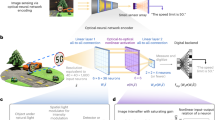Computer vision algorithms for inspection or pick-and-place operations often depend on spatially uniform illumination of a workplace. This necessitates expensive lighting fixtures. To discount effects of uneven illumination we designed and tested a neural network that can adaptively control light sensitivity at the photosensor level. Our neural network architecture consists of multiple layers with hexagonally arranged nodes. All nodes have partially overlapping receptive fields of different spatial frequencies. Feedforward connections are excitatory while feedback pathways subserve lateral inhibition. The outputs of these nodes are combined so as to maximize the signal-to-noise ratio while constantly resetting thresholds to maintain high sensitivity. Our connectionist architecture can account for many characteristics attributed to the lightness constancy phenomenon observed in biological systems. The results suggest that our module maintains high sensitivity over the whole domain of intensities without interfering with transmission of visual information embedded in spatial discontinuities of intensity.
Similar content being viewed by others
References
Baylor, D. A., Fuortes, M. G. F. and O'Bryan, P. M. (1971) Receptive fields of single cones in the retina of the turtle, Journal of Physiology, 214, 265–294.
Baylor, D. A., Hodgkin, A. L. and Lamb, T. D. (1974) The electrical responses of turtle retina to flashes and steps of light, Journal of Physiology, 242, 685–727.
Binford, T. (1981) Inferring surface information from images, Artificial Intelligence, 17, 205–241.
Blake, A. (1985) Boundary conditions for lightness computation in Mondrian World, Computer Vision, Graphics and Image Processing, 32, 314–327.
Burt, T. J. (1980) Tree and pyramid structures for coding hexagonally sampled binary images, Computer Graphics and Image Processing, 14, 271–284.
Caldwell, J. H. and Daw, N. W. (1978) New properties of rabbit retinal ganglion cells, Journal of Physiology, 276, 257–276.
Canny, J. F. (1983) Finding edges and lines in images, MIT Artificial Intelligence Laboratory Technical Report 720.
Copenhagen, D. R. and Owen, W. G. (1976) Functional characteristics of lateral interactions between rods in the retina of the snapping turtle, Journal of Physiology, 259, 251–282.
Dowling, J. E. and Ripps, H. (1972) Adaptation in skate photoreceptors, Journal of General Physiology, 60, 698–719.
Feldman, J. A. (1985) Connectionist models and parallelism in high level vision, Computer Vision, Graphics and Image Processing, 31, 178–200.
Gilchrist, A. (1977) Perceived lightness depends on perceived spatial arrangement, Science, 195, 185–187.
Hopfield, J. J. and Tank, D. W. (1986) Computing with neural circuits: a model, Science, 233, 625–633.
Horn, B. K. (1974) Determining lightness from an image, Computer Graphics and Image Processing, 3, 277–299.
Kolb, H. and Normann, R. A. (1982) A-type horizontal cells of the superior edge of the linear visual streak of the rabbit retina have oriented, elongated dendritic trees, Vision Research, 22, 905–916.
Land, E. M. (1983) Recent advances in Retinex theory and some implications for cortical computations: color vision and the natural image, Proceedings of the National Academy of Science, USA, 80, 5163–5169.
Land, E. and McCann, J. J. (1971) Lightness theory, Journal of the Optical Society, 61, 1–11.
Marr, D. (1974) The computation of lightness by the primate retina, Vision Research, 14, 1377–1388.
Marr, D. (1982) Vision, Freeman.
Marr, D. and Hildreth, E. C. (1980) Theory of edge detection, Proceedings of the Royal Society of London B, 207, 187–217.
Naka, K. and Rushton, W. A. H. (1966) S potentials from intensity units in the retina of fish (cyprinidae), Journal of Physiology, 185, 587–599.
Pratt, W. K. (1978) Digital Image Processing, J. Wiley & Sons, New York.
Ratliff, F. (1965) Mach Bands: Quantitative Studies on Neural Networks in Retina, Holden Day.
Richards, W. A. (1981) A lightness scale from image intensity distribution, MIT AI Memo No. 648.
Rodieck, R. W. (1973) The Vertebrate Retina, Freeman and Company.
Schade, O. H. (1956) Optical and photoelectric analog of the eye, Journal of the Optical Society of America, 46, 721–739.
Skrzypek, J. (1979) PhD Thesis, University of California at Berkeley.
Skrzypek, J. (1988) Light adaptation and feedback to cones, (submitted).
Skrzypek, J. and Werblin, F. S. (1978) All horizontal cells in tiger salamander retina have concentric antagonistic receptive fields, ARVO Abstracts, 261.
Skrzypek, J. and Werblin, F. S. (1983) Lateral interactions in the absence of feedback to cones, Journal of Neurophysiology, 49, 1007–1016.
Ullman, S. and Schechtman, G. (1982) Adaptation and gain normalization, Proceedings of the Royal Society of London B, 216, 299–313.
Van Buren, J. M. (1963) The Retinal Ganglion Cell Layer, Thomas.
Wallach, H. (1948) Brightness constancy and the nature of achromatic colors, Journal of Experimental Psychology, 38, 310–324.
Werblin, F. S. and Dowling, J. E. (1969) Organization of the retina of mudpuppy, Necturus Maculosus. II. Intracellular recording. Journal of Neurophysiology, 32, 339–356.
Wilson, H. R. and Bergen, J. R. (1979) A four mechanism model for threshold spatial vision, Vision Research, 19, 19–32.
Witkowsky, P. (1980) Excitation and adaptation in the vertebrate retina, in Current Topics in Eye Research, Academic Press vol. 2, pp. 1–66.
Author information
Authors and Affiliations
Rights and permissions
About this article
Cite this article
Skrzypek, J. Neural architecture for robotic vision sensor that discounts uneven illumination in a manufacturing environment. J Intell Manuf 4, 67–77 (1993). https://doi.org/10.1007/BF00124981
Issue Date:
DOI: https://doi.org/10.1007/BF00124981




